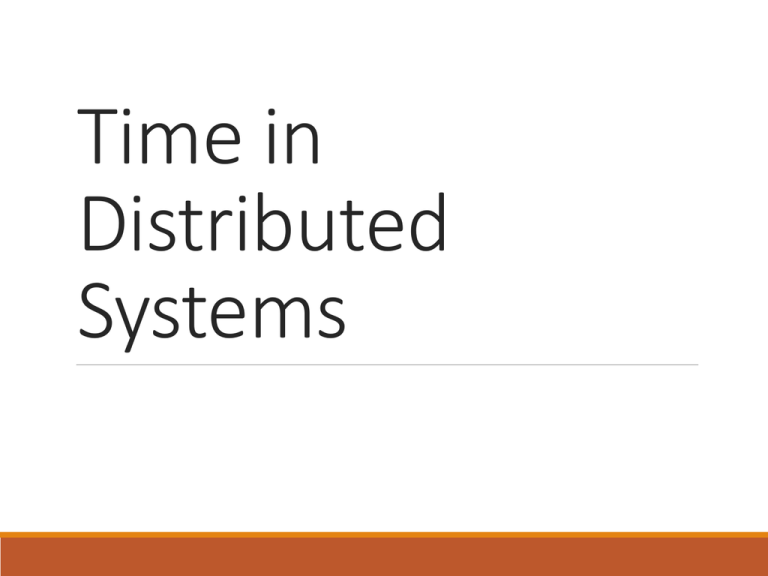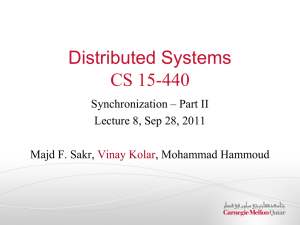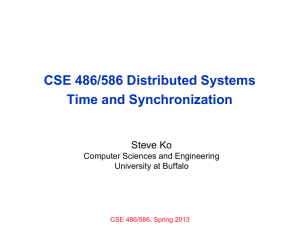06TimeStamps
advertisement

Time in
Distributed
Systems
Outline
Physical Time
NTP in Distributed Systems
Lamport Logic Time
Vector Clock
File Synchronization with Vector Time Pairs
Physical Time
The standard second has been defined as 9,192,631,770 cycles of
radiation emitted by Cs133. This is standard on Jan 1, 1958. The time
defined in form is called as TAI (International Atomic Time since 1967).
The solar second equals 1/(24*3600) of the solar day. This is measured
by the interval between the two points where the sun reaches the
highest position (at noon)
However, the solar time is not strictly the same as it gets longer and
longer. (about 30 TAI seconds in the past 40 years.
Global Time Standard
Coordinated Universal Time (UTC) : is the primary time standard by
which the world regulates clocks and time. It is one of several closely
related successors to Greenwich Mean Time (GMT). For most common
purposes, UTC is synonymous with GMT, but GMT is no longer
precisely defined by the scientific community.
UTC is based on International Atomic Time (TAI)
◦ a time standard calculated using a weighted average of signals from atomic
clocks located in nearly 70 national laboratories around the world.
UTC is occasionally adjusted by adding a leap second in order to keep
it within one second of UT1
◦ UT1 is defined by the earth rotation
Comparing Time Standards
UT1 − UTC
Computer clocks
Each computer is equipped with a clock, however this clock is unlikely
to tick at the exactly same rate.
◦ A quartz crystal clock has a drift rate of 10-6 (ordinary), or 10-7 to 10-8 (high
precision)
◦ For comparison, an atomic clock has a drift rate of 10-13
Clock skew: the instantaneous difference between two clocks
Clock drift rate: difference between the clock and a nominal perfect
reference clock per unit of time
Time differences
Each machine sends a message to the time server and asking for the
current time.
And this is the round-trip delay
Offset (time difference between to machines)
Cristian’s algorithm
Cristian's Algorithm works between a process P, and a time server S —
connected to a source of UTC (Coordinated Universal Time).
◦ 1 P requests the time from S
◦ 2 After receiving the request from P, S prepares a response and appends the
time T from its own clock.
◦ 3 P then sets its time to be T + RTT/2
This method assumes that the RTT is split equally between both request and
response, which may not always be the case but is a reasonable assumption
on a LAN connection.
Further accuracy can be gained by making multiple requests to S and using
the response with the shortest RTT.
Berkeley algorithm
The time daemon (master) asks all the other machines for their clock values.
The master estimates the clients local time (using Cristian’s algorithm) and
averages the time (excluding those drifted badly).
Master sends adjustments back to all the clients. (Why not the actual clock value?)
Averaging Algorithms
Each machine broadcasts its current time.
The local machine collects all other broadcast time samples during
some time interval.
The new local time is set as the average of the value received from all
other machines.
The simple algorithm: the new local time is set as the average of the
value received from all other machines. (using Cristian’s algorithm)
NTP Overview
NTP provides Coordinated Universal Time(UTC) including scheduled
leap second adjustments.
NTP uses Marzullo’s algorithm and is designed to resist the effects of
variable latency.
NTP can usually maintain time to within tens of milliseconds over the
public Internet, and can achieve 1 millisecond accuracy in local area
networks under ideal conditions.
The protocol uses the UDP on port number 123.
Developed in 1985 by David Mills at the University of Delaware, USA
and still maintained by him.
Differences to Cristian’s method
and the Berkeley algorithm
CM and BA are both designed for primarily use in intranets
NTP was designed for use in the Internet
CM and BA both synchronize against on time server
NTP synchronizes against many time servers
Clock strata
NTP uses a hierarchical, semi-layered system of levels of clock sources.
Each level of this hierarchy is termed astratum and is assigned a layer
number starting with 0 (zero) at the top.
The stratum level defines its distance from the reference clock and
exists to prevent cyclical dependencies in the hierarchy.
Stratum 0: These are devices such as atomic (cesium, rubidium) clocks,
GPS clocks or other radio clocks.
Stratum 1: These are computers attached to Stratum 0 devices.
Normally they act as servers for timing requests from Stratum 2
servers via NTP. These computers are also referred to as time servers.
Stratum 2, Stratum 3, …… stratum 255. Only the first 16 are employed
and any device at Stratum 16 is considered to be unsynchronized.
Layered system
Stratum 2 computer will
reference a number of Stratum 1
servers and use the NTP
algorithm to gather the best data
sample, dropping any Stratum 1
servers that seem obviously
wrong. Stratum 2 computers will
peer with other Stratum 2
computers to provide more
stable and robust time for all
devices in the peer group.
Stratum 2 computers normally
act as servers for Stratum 3 NTP
requests.
Yellow arrows indicate a direct
connection; red arrows indicate a
network connection.
NTP timestamps
The 64-bit timestamps used by NTP consist of a 32-bit part for seconds
and a 32-bit part for fractional second.
Giving NTP a time scale that rolls over every 232 seconds (136 years)
and a theoretical resolution of 2−32 seconds (233 picoseconds).
NTP uses an epoch of January 1, 1900. The first rollover occurs in 2036.
Marzullo’s algorithm
Marzullo's algorithm, invented by Keith Marzullo for his Ph.D.
dissertation in 1984
An agreement algorithm used to select sources for estimating
accurate time from a number of noisy time sources.
The best estimate is taken to be the smallest interval consistent with
the largest number of sources.
Example 1
[11,12] or 11.5 ± 0.5
as consistent with all
three values.
Example 2
[11,12] is consistent
with the largest
number of sources
Example 3
both the intervals [8,9]
and [10,12] are
consistent with the
largest number of
sources.
Marzullo’s Algorithm result
If the desired result is a best value from that interval then a naive
approach would be to take the center of the interval as the value.
For example, consider three intervals [10,12], [11, 13] and [11.99,13].
The algorithm computes [11.99, 12] or 11.995 ± 0.005 which is a very
precise value.
If we suspect that one of the estimates might be incorrect, then at
least two of the estimates must be correct. Under this condition, the
best estimate is [11,13] since this is the largest interval that always
intersects at least two estimates.
NTP currently use Intersection Algorithm which is the modified version
of Marzullo’s algorithm
Intersection algorithm
While Marzullo's Algorithm will return the smallest interval consistent
with the largest number of sources, the returned interval does not
necessarily include the center point (calculated offset) of all the
sources in the intersection.
The Intersection Algorithm returns an interval that includes that
returned by Marzullo's algorithm but may be larger since it will include
the center points.
This larger interval allows using additional statistical data to select a
point within the interval, reducing the jitter in repeated execution.
Leap seconds
NTP delivers UTC time.
UTC is subject to scheduled leap seconds to synchronize the timescale
to the rotation of the earth.
When a leap second is added, NTP is suspended for 1 second.
◦ Because NTP has no mechanism for remembering the history of leap
seconds, leap seconds cause the entire NTP timescale to shift by 1 second.
Physical time is not strict
No absolute time that can be used to synchronize the time of even
two machines exactly
Sometimes, the physical time might be sufficient for some applications
over internet, it will not be good for algorithms.
Often, the physical time is not adequate for defining the orders of
events in distributed systems
Logical time
For capturing the “happen before” relationship between events
◦ Events means the local operation internal to a process (or thread), or the
send and recv operations link two or more threads
◦ Logical time can discard the requirement to infinite precision of physical
time
◦ Lamport showed clock synchronization need not be absolute but the order
of events matters
Happen before
Lamport defined a relation “happen before”. ab means a happens
before b.
(1) if a and b are events in the same process, and a comes before b,
then ab.
(2) if a is the sending of a message by one process and b is the receipt
of the same message by another process, then ab.
(3) if ab and bc then ac
Two distinct events a and b are sad to be concurrent if
Time diagram
Logical Clocks: C(e)
Clock Condition: if any events a, b: if a b then C(a) <C(b)
C1: if a and be are events in process Pi and a comes before b, then
Ci(a)<Ci(b)
C2: if a is the sending of a message by process Pi and b is the receipt of
that message by process Pj, then Ci(a) <Cj(b)
Can converse? if any events a, b: if a b then C(a) <C(b)
Logical Clock Illustration
Logical Time assignment
IR1: Each process Pi increments Ci between any two successive events.
IR2: (a) if event a is the sending of a message m by process Pi, then the
message m contains a timestamp Tm=Ci(a). (b) Upon receiving a
message m, process Pj sets Cj greater than or equal to its present
value and greater than Tm.
Logical Time can be used to order the events totally.
◦ With the partial order of logical time
◦ With the total order of processes
Vector Clocks
We want to assign the values to the event to cope with the happen
before relation ship (matches causality)
Steps to build the vector clock:
◦ Initially all clocks are zero.
◦ Each time a process experiences an internal event, it increments its own
logical clock in the vector by one.
◦ Each time a process prepares to send a message, it increments its own
logical clock in the vector by one and then sends its entire vector along with
the message being sent.
◦ Each time a process receives a message, it increments its own logical clock
in the vector by one and updates each element in its vector by taking the
maximum of the value in its own vector clock and the value in the vector in
the received message (for every element).
Example of Vector Clock
Example of a system of vector clocks. Events in the blue region are the causes
leading to event B4, whereas those in the red region are the effects of event B4
Partial ordering property
Vector Clock Properties
Relation with other orders
Important Summary
Physical Clocks
◦ Can keep closely synchronized, but never perfect
Logical Clocks
◦ Encode causality relationship
◦ Lamport (logical) clocks provide only one-way encoding
◦ Vector clocks provide exact causality information
File Synchronization with
Vector Time Pairs
So, we put the vector clocks on practical use for synchronize the files
among multiple machines.
The idea is to use version vector:
◦ A version vector is a mechanism for tracking changes to data in a distributed
system, where multiple agents might update the data at different times.
◦ Version vectors enable causality tracking among data replicas and are a basic
mechanism for optimistic replication.
Version vector maintain state identical to that in a vector clock, replicas
can either experience local updates (e.g., the user editing a file on the
local node), or can synchronize with another replica:
◦ Initially all vector counters are zero
◦ Each time a replica experiences a local update event, it increments its own
couter in the vector by one
◦ Each time two replicas a and b synchronize, they both set the elements in their
copy of the vector to the maximum of the element across both counters:
Va[x]=Vb[x]=max(Va[x], Vb[x]). After synchronization the two replicas have
identical version vectors.
An ideal file synchronizer:
Impose no restrictions or requirements on the synchronization
patterns between computers. (suppose there are 3 computers A,B and
C, any pair should be allowed to synchronize at any time
Detect all conflicts without any false positives
Propagate file deletions without wasting space remembering files that
once existed
Identify the set of files differing between two computers using
network bandwidth proportions to the size of the set (instead of the
size of whole file system)
Support partial synchronization restricted to subtrees of the file
system
Single file synchronization (no
lost updates)
Each file is represented by
a history of modifications
made over the course of its
lifetime.
suppose each file is
represented by a history of
modifications.
If two replicas have
different copies of a file
(call the copies X and Y), it
is safe to replace X with Y
only if X’s history is a prefix
of Y’s.
Synchronizing Modifications
Recording Conflict Resolutions
Synchronizing Creations and
Deletions
Deletion is not modification
Synchronizing File Trees
No worse than manual copying of files.
The amount of network bandwidth consumed should be proportional
to the amount of changed data, not the entire file tree.
The synchronizer should support synchronizations of subtrees and
individual files.
Version vectors
Single-file Synchronization
using version vectors
Vector Time Pair Algorithm
Vector time pairs
◦ Vector modification time
(version vector)
◦ Tracks “which version we have”
◦ Vector synchronization time
◦ Tracks “How much we know”
Vector Synchronization Time
The version stored on
replica C at time 5 has
modification time {A1,
B4} and synchronization
time {A2, B4, C5}
Single file synchronization
using vector time pairs
Nothing happened to a file
between its modification time
and the synchronization time,
mA ≤ mB if and only if mA ≤ sB.
(One direction follows from the
fact that mB ≤ sB. The other
direction follows from the fact
that all modification events in sB
are contained in mB.)
Recording Conflict Resolutions
Recording conflict resolution 1
Recording conflict resolution 2
Recording conflict resolution 3
Synchronizing Deletions
Track each existing file’s
creation time in addition to
its vector time pair. (The
creation is the first element
in the file’s modification
history.)
The only metadata about the
deleted file that the new
algorithm uses is its
synchronization time.
Absorbed by the
synchronization time for
directories
Synchronizing Deletions 1
Synchronizing Deletions 2
Synchronizing Deletions 3
Synchronizing File Trees
The vector
synchronization time of
a directory is the
element-wise
minimum of the
synchronization times
of its children.
The modification time
of a directory is the
element-wise
maximum of the
modification times of
its children.
Partial Synchronization of File
System Tree
A creates two different files x and y in the directory d at time A1. A partial
sync copies x to replica B and another partial sync copies y to replica C.
Can we shrink the metadata
storage cost?
Encoding synchronization times
◦ For a given file or directory, we need to store only the vector differences
between the file/dir vector synchronization time and its parent dir vector
synchronization time.
◦ For most synchronization patters, these differences will be zero vectors.
◦ Deletion notices require no storgethe synchronization time is the only
metadata associated with a deletion notice.
Encoding modification times
◦ Modification times can often be reduced to scalars without changing the
result of comparisons
◦ m ≤ s the last element in m decide the result of the comparison
◦ For files : only record the last modification
◦ For directories: no optimization because no “last change”, think about the
definition of m for dir
Thank you , any questions?








